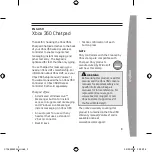
6 . P o w e r a n d Ad a p t e r s U n i ts
M N 0 5 0 0 3 0 0 6 E F o r m o r e i n f o r m a t i o n v i s i t :
w w w. e a t o n . c o m
6-7
Fig. 3a
MVX 9000
E
L
C-
E
X
0
8
NNDN
RS
-2
3
2
RS
-4
8
5
x16
E
L
C-
P
C
1
2
NND
R
0
1
STOP
0
1
RUN
x16
E
L
C-
CO
P
B
D
P
Fig. 3b
PIN Explanation of COM1, COM2, and RJ12
COM1-DB9
female
PIN
Definition
RJ12 of AC Motor
Drive side
PIN
Definition
1 RS485-
1 +15V
2 RS485+
2 GND
3 RS485+
3 SG-
4 RS485-
4 SG+
1
2
3
4
5
6
7
8
9
5~9 NC
5, 6
Reserved
COM2-DB9 male
PIN
Definition
RJ12 of
ELC-485APTR side
PIN
Definition
3, 6
RS485-
3
RS-485+
8 RS485+
4 RS-485-
5, 9
GND
5
GND
5
2
1
4
3
6
7
8
9
1, 2, 4, 7
NC
1, 2, 6
NC
Termination Resistor Application
In all RS-485 installations, the cable must be correctly terminated with two sets of resistors, one
set at each end of the network (4,000 feet maximum total cable length). This applies even if you
are only using one slave node connected to one master device. The terminating resistors
prevent reflection problems that can interfere with data transmission. The resistance value of
the terminating resistors should match the characteristic impedance of the cable. A typical value
is 120 ohms. The terminating resistors must be placed at the two farthest ends of the RS-485
network, regardless of where the master device is. In some cases master device RS-485 ports
have built in or optional terminating resistors. Beware of your network (whether it has one node
or 32 nodes) having only two sets of terminating resistors.


































